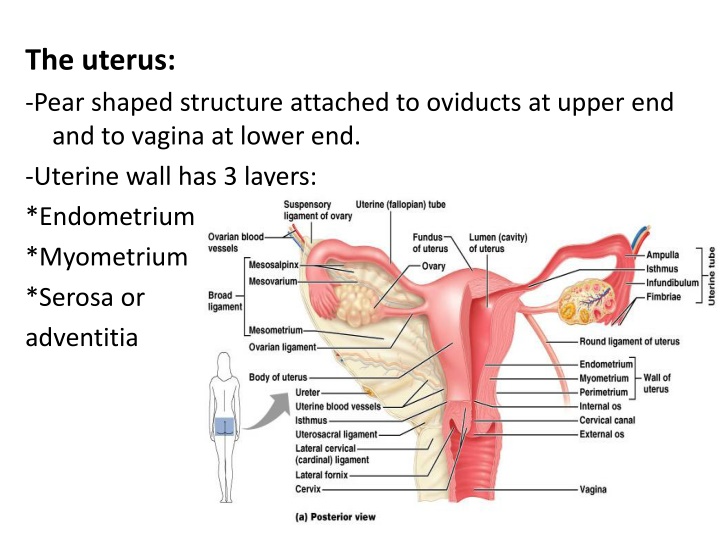
Anatomy of the Uterus and Cervix
Learn about the structure of the uterus, including its layers - endometrium, myometrium, and serosa or adventitia. Explore the function of the endometrium and myometrium, and discover the detailed composition of the uterine cervix, including its mucous secretions and glandular activities.
Download Presentation

Please find below an Image/Link to download the presentation.
The content on the website is provided AS IS for your information and personal use only. It may not be sold, licensed, or shared on other websites without obtaining consent from the author. If you encounter any issues during the download, it is possible that the publisher has removed the file from their server.
You are allowed to download the files provided on this website for personal or commercial use, subject to the condition that they are used lawfully. All files are the property of their respective owners.
The content on the website is provided AS IS for your information and personal use only. It may not be sold, licensed, or shared on other websites without obtaining consent from the author.
E N D
Presentation Transcript
The uterus: -Pear shaped structure attached to oviducts at upper end and to vagina at lower end. -Uterine wall has 3 layers: *Endometrium *Myometrium *Serosa or adventitia
*Endometrium -composed of simple columnar epithelium invaginated in to simple tubular glands, ciliated columnar cells and secretory columnar cells. -lamina propria composed of highly cellular connective tissue and vessels. -two zones in Endometrium: 1-Functinal layer - a thick superficial layer that is sloughed off during menstruation. - Replaced during each menstrual cycle. - Is vascular zed by numerous coiled arteries.
2-Basal layer - A deeper layer, narrow whose glands and connective tissue elements retained after menstruation. - Gland cells give rise to new epithelium. *Myometrium -thickest muscular layer wall of the uterus. -composed of three layers of smooth muscle separated by connective tissue. -inner and outer layers are mostly longitudinal in orientation. -middle layers are more circular, thickens in pregnancy with more smooth muscle cells and increased collagen. -the size and number of the myometrial muscle cell related to estrogen level.
2-Basal layer - A deeper layer, narrow whose glands and connective tissue elements retained after menstruation. - Gland cells give rise to new epithelium. *Myometrium -thickest muscular layer wall of the uterus. -composed of three layers of smooth muscle separated by connective tissue. -inner and outer layers are mostly longitudinal in orientation. -middle layers are more circular, thickens in pregnancy with more smooth muscle cells and increased collagen. -the size and number of the myometrial muscle cell related to estrogen level.
*Serosa or Adventitia -much of its anterior portion is covered by adventitia consist of connective tissue without an epithelial covering. -the fundus and posterior portion of the body are covered by a serosa, composed of a layer of squamous mesothelium cells resting on areolar c.t
Uterine cervix -lower part of uterus. -lined by mucous secretion simple columnar epithelium. -some smooth muscle and much connective tissue in lamina propria. -part of cervix in upper vagina has stratified squamous no keratinized epithelium. -cervical mucosa has mucous glands. -less branching no coiled artery, thicker Endometrium and thinner Myometrium. -cervical mucosa remains intact during menstrual cycle. -Cervical gland secretions vary during menstrual cycle. -at ovulation mucous is watery so sperm can penetrate easily, in luteal phase or pregnancy mucous more viscous to block sperm or microbes.
Vagina -epithelium is stratified squamous partly keratinized. -no glands in epithelium. -underlying lamina propria of loose connective tissue, highly vascular zed with many elastic fibers. -muscular layer of circular and longitudinal smooth muscle. -adventitia of dense irregular connective tissue with elastic fibers, many vessels and nerves.
